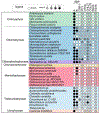From economy to luxury: Copper homeostasis in Chlamydomonas and other algae
- PMID: 32800924
- PMCID: PMC7484467
- DOI: 10.1016/j.bbamcr.2020.118822
From economy to luxury: Copper homeostasis in Chlamydomonas and other algae
Abstract
Plastocyanin and cytochrome c6, abundant proteins in photosynthesis, are readouts for cellular copper status in Chlamydomonas and other algae. Their accumulation is controlled by a transcription factor copper response regulator (CRR1). The replacement of copper-containing plastocyanin with heme-containing cytochrome c6 spares copper and permits preferential copper (re)-allocation to cytochrome oxidase. Under copper-replete situations, the quota depends on abundance of various cuproproteins and is tightly regulated, except under zinc-deficiency where acidocalcisomes over-accumulate Cu(I). CRR1 has a transcriptional activation domain, a Zn-dependent DNA binding SBP-domain with a nuclear localization signal, and a C-terminal Cys-rich region that represses the zinc regulon. CRR1 activates >60 genes in Chlamydomonas through GTAC-containing CuREs; transcriptome differences are recapitulated in the proteome. The differentially-expressed genes encode assimilatory copper transporters of the CTR/SLC31 family including a novel soluble molecule, redox enzymes in the tetrapyrrole pathway that promote chlorophyll biosynthesis and photosystem 1 accumulation, and other oxygen-dependent enzymes, which may influence thylakoid membrane lipids, specifically polyunsaturated galactolipids and γ-tocopherol. CRR1 also down-regulates 2 proteins in Chlamydomonas: for plastocyanin, by activation of proteolysis, while for the di‑iron subunit of the cyclase in chlorophyll biosynthesis, through activation of an upstream promoter that generates a poorly-translated 5' extended transcript containing multiple short ORFs that inhibit translation. The functions of many CRR1-target genes are unknown, and the copper protein inventory in Chlamydomonas includes several whose functions are unexplored. The comprehensive picture of cuproproteins and copper homeostasis in this system is well-suited for reverse genetic analyses of these under-investigated components in copper biology.
Keywords: Chlamydomonas; Chlorophyte algae; Chloroplast; Copper nutrition; Ferredoxin; Photosynthesis.
Copyright © 2020 Elsevier B.V. All rights reserved.
Conflict of interest statement
Declaration of competing interest The authors declare that they have no known competing financial interests or personal relationships that could have appeared to influence the work reported in this paper.
Figures






References
-
- Cvetkovic A, Menon AL, Thorgersen MP, Scott JW, Poole FL 2nd, Jenney FE Jr., Lancaster WA, Praissman JL, Shanmukh S, Vaccaro BJ, Trauger SA, Kalisiak E, Apon JV, Siuzdak G, Yannone SM, Tainer JA, Adams MW, Microbial metalloproteomes are largely uncharacterized, Nature., 466 (2010) 779–782 Epub 2010 Jul 2018. - PubMed
-
- Crichton RR, Pierre JL, Old iron, young copper: from Mars to Venus, Biometals, 14 (2001) 99–112. - PubMed
-
- Harris EH, The Chlamydomonas Sourcebook: A comprehensive guide to biology and laboratory use, Academic Press, Place Published, 1989. - PubMed

